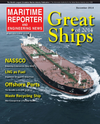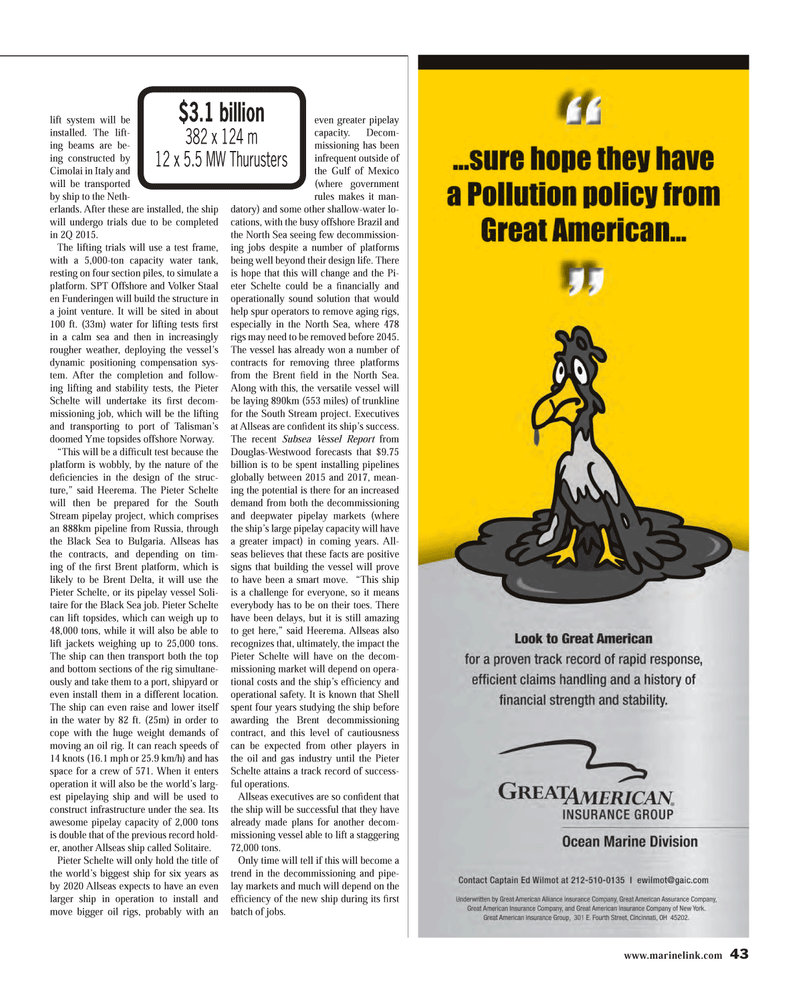
Page 43: of Maritime Reporter Magazine (December 2014)
Great Ships of 2014
Read this page in Pdf, Flash or Html5 edition of December 2014 Maritime Reporter Magazine
www.marinelink.com 43 lift system will be installed. The lift- ing beams are be- ing constructed by
Cimolai in Italy and will be transported by ship to the Neth- erlands. After these are installed, the ship will undergo trials due to be completed in 2Q 2015.
The lifting trials will use a test frame, with a 5,000-ton capacity water tank, resting on four section piles, to simulate a platform. SPT Offshore and Volker Staal en Funderingen will build the structure in a joint venture. It will be sited in about 100 ft. (33m) water for lifting tests fi rst in a calm sea and then in increasingly rougher weather, deploying the vessel’s dynamic positioning compensation sys- tem. After the completion and follow- ing lifting and stability tests, the Pieter
Schelte will undertake its fi rst decom- missioning job, which will be the lifting and transporting to port of Talisman’s doomed Yme topsides offshore Norway. “This will be a diffi cult test because the platform is wobbly, by the nature of the defi ciencies in the design of the struc- ture,” said Heerema. The Pieter Schelte will then be prepared for the South
Stream pipelay project, which comprises an 888km pipeline from Russia, through the Black Sea to Bulgaria. Allseas has the contracts, and depending on tim- ing of the fi rst Brent platform, which is likely to be Brent Delta, it will use the
Pieter Schelte, or its pipelay vessel Soli- taire for the Black Sea job. Pieter Schelte can lift topsides, which can weigh up to 48,000 tons, while it will also be able to lift jackets weighing up to 25,000 tons.
The ship can then transport both the top and bottom sections of the rig simultane- ously and take them to a port, shipyard or even install them in a different location.
The ship can even raise and lower itself in the water by 82 ft. (25m) in order to cope with the huge weight demands of moving an oil rig. It can reach speeds of 14 knots (16.1 mph or 25.9 km/h) and has space for a crew of 571. When it enters operation it will also be the world’s larg- est pipelaying ship and will be used to construct infrastructure under the sea. Its awesome pipelay capacity of 2,000 tons is double that of the previous record hold- er, another Allseas ship called Solitaire.
Pieter Schelte will only hold the title of the world’s biggest ship for six years as by 2020 Allseas expects to have an even larger ship in operation to install and move bigger oil rigs, probably with an even greater pipelay capacity. Decom- missioning has been infrequent outside of the Gulf of Mexico (where government rules makes it man- datory) and some other shallow-water lo- cations, with the busy offshore Brazil and the North Sea seeing few decommission- ing jobs despite a number of platforms being well beyond their design life. There is hope that this will change and the Pi- eter Schelte could be a fi nancially and operationally sound solution that would help spur operators to remove aging rigs, especially in the North Sea, where 478 rigs may need to be removed before 2045.
The vessel has already won a number of contracts for removing three platforms from the Brent fi eld in the North Sea.
Along with this, the versatile vessel will be laying 890km (553 miles) of trunkline for the South Stream project. Executives at Allseas are confi dent its ship’s success.
The recent Subsea Vessel Report from
Douglas-Westwood forecasts that $9.75 billion is to be spent installing pipelines globally between 2015 and 2017, mean- ing the potential is there for an increased demand from both the decommissioning and deepwater pipelay markets (where the ship’s large pipelay capacity will have a greater impact) in coming years. All- seas believes that these facts are positive signs that building the vessel will prove to have been a smart move. “This ship is a challenge for everyone, so it means everybody has to be on their toes. There have been delays, but it is still amazing to get here,” said Heerema. Allseas also recognizes that, ultimately, the impact the
Pieter Schelte will have on the decom- missioning market will depend on opera- tional costs and the ship’s effi ciency and operational safety. It is known that Shell spent four years studying the ship before awarding the Brent decommissioning contract, and this level of cautiousness can be expected from other players in the oil and gas industry until the Pieter
Schelte attains a track record of success- ful operations.
Allseas executives are so confi dent that the ship will be successful that they have already made plans for another decom- missioning vessel able to lift a staggering 72,000 tons.
Only time will tell if this will become a trend in the decommissioning and pipe- lay markets and much will depend on the effi ciency of the new ship during its fi rst batch of jobs. $3.1 billion 382 x 124 m 12 x 5.5 MW Thurusters
MR #12 (42-49).indd 43 12/4/2014 10:12:42 AM

 42
42

 44
44
